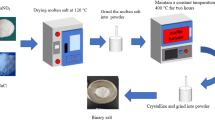Abstract
The thermo-physical properties of NaNO3/KNO3 (solar salt) added with Al2O3 and TiO2 nanoparticles as phase change material in thermal energy storage system were investigated. Initially the Al2O3 and TiO2 nanoparticles were added to NaNO3/KNO3 (60:40) with a concentration of 1%, 3% and 5 mass% using low-energy ball mill. The differential scanning calorimetry instrument is used to measure the thermal properties of the prepared PCM composites. It is found that the phase change temperature and latent heat capacity vary with Al2O3 and TiO2 nanoparticles loading levels. When the loading is not over 3 mass% of Al2O3, the phase change temperature drops, and the latent heat capacity increases up to 23.3%. When the loading is over 3 mass% of Al2O3, the phase change temperature increases, and the latent heat capacity drops to 14.23%. A significant increase in latent heat capacity is found around 3 mass% of Al2O3 loading. When the TiO2 nanoparticle concentration increases, the phase change temperature decreases, and the latent heat capacity increases up to 32.2%. When the TiO2 nanoparticle’s concentration decreases, the phase change temperature increases, and the latent heat capacity decreases. The thermal conductivity of the composites was found to increase with the increase in the loading of nanoparticles. After adding 3% by mass of Al2O3 and TiO2 nanoparticles, the thermal conductivity was found to increase by 8.30 and 8.10%, respectively. From the characterization studies, we found that TiO2 helps to achieve the improved thermo-physical properties and heat storage characteristics for NaNO3/KNO3 which suggests their potential candidate of usage in the thermal energy storage system.




Similar content being viewed by others
Abbreviations
- PCM:
-
Phase change material
- DSC:
-
Differential scanning calorimetry
- TGA:
-
Thermogravimetric analysis
- SEM:
-
Scanning electron microscopy
- wt.:
-
Mass
- C :
-
Specific heat of PCM/water (J kg−1 °C)
- H :
-
Latent heat of phase change material (PCM) (J kg−1)
- K :
-
Thermal conductivity (W m−1 K−1)
- T :
-
Temperature (°C)
References
Dincer I, Rosen M. Thermal energy storage: systems and applications. Hoboken: Wiley; 2002.
Tian Y, Zhao CY. A review of solar collectors and thermal energy storage in solar thermal applications. Appl Energy. 2013;1(104):538–53.
Sharma A, Tyagi VV, Chen CR, Buddhi D. Review on thermal energy storage with phase change materials and applications. Renew Sustain Energy Rev. 2009;13(2):318–45.
Farid MM, Khudhair AM, Razack SA, Al-Hallaj S. A review on phase change energy storage: materials and applications. Energy Convers Manag. 2004;45(9–10):1597–615.
Tao YB, He YL. A review of phase change material and performance enhancement method for latent heat storage system. Renew Sustain Energy Rev. 2018;31(93):245–59.
Xiao X, Zhang P, Li M. Experimental and numerical study of heat transfer performance of nitrate/expanded graphite composite PCM for solar energy storage. Energy Convers Manag. 2015;15(105):272–84.
Salyan S, Suresh S. Liquid metal gallium laden organic phase change material for energy storage: an experimental study. Int J Hydrogen Energy. 2018;43(4):2469–83.
Salyan S, Suresh S. Study of thermo-physical properties and cycling stability of d-Mannitol-copper oxide nanocomposites as phase change materials. J Energy Storage. 2018;28(15):245–55.
Huang Y, Cheng X, Li Y, Yu G, Xu K, Li G. Effect of in situ synthesized nano-MgO on thermal properties of NaNO3–KNO3. Sol Energy. 2018;15(160):208–15.
Venkitaraj KP, Suresh S. Experimental study on thermal and chemical stability of pentaerythritol blended with low melting alloy as possible PCM for latent heat storage. Exp Thermal Fluid Sci. 2017;1(88):73–87.
Venkitaraj KP, Suresh S, Praveen B, Venugopal A, Nair SC. Pentaerythritol with alumina nano additives for thermal energy storage applications. J Energy Storage. 2017;1(13):359–77.
Karaipekli A, Biçer A, Sarı A, Tyagi VV. Thermal characteristics of expanded perlite/paraffin composite phase change material with enhanced thermal conductivity using carbon nanotubes. Energy Convers Manag. 2017;15(134):373–81.
Chieruzzi M, Miliozzi A, Crescenzi T, Torre L, Kenny JM. A new phase change material based on potassium nitrate with silica and alumina nanoparticles for thermal energy storage. Nanoscale Res Lett. 2015;10(1):273.
Chieruzzi M, Cerritelli GF, Miliozzi A, Kenny JM. Effect of nanoparticles on heat capacity of nanofluids based on molten salts as PCM for thermal energy storage. Nanoscale Res Lett. 2013;8(1):448.
Zhao YJ, Wang RZ, Wang LW, Yu N. Development of highly conductive KNO3/NaNO3 composite for TES (thermal energy storage). Energy. 2014;1(70):272–7.
Xiao X, Zhang P, Li M. Experimental and numerical study of heat transfer performance of nitrate/expanded graphite composite PCM for solar energy storage. Energy Convers Manag. 2015;15(105):272–84.
Singh DK, Suresh S, Singh H. Graphene nanoplatelets enhanced myo-inositol for solar thermal energy storage. Therm Sci Eng Progr. 2017;1(2):1–7.
Singh DK, Suresh S, Singh H, Rose BA, Tassou S, Anantharaman N. Myo-inositol based nano-PCM for solar thermal energy storage. Appl Therm Eng. 2017;5(110):564–72.
Schuller M, Shao Q, Lalk T. Experimental investigation of the specific heat of a nitrate–alumina nanofluid for solar thermal energy storage systems. Int J Therm Sci. 2015;31(91):142–5.
Maldonado JM, Fullana-Puig M, Martín M, Solé A, Fernández ÁG, de Gracia A, Cabeza LF. Phase change material selection for thermal energy storage at high temperature range between 210°C and 270°C. Energies. 2018;11(4):861.
Rao ZH, Zhang GQ. Thermal properties of paraffin wax-based composites containing graphite. Energy Sources Part A Recovery Util Environ Effects. 2011;33(7):587–93.
Author information
Authors and Affiliations
Corresponding author
Additional information
Publisher's Note
Springer Nature remains neutral with regard to jurisdictional claims in published maps and institutional affiliations.
Rights and permissions
About this article
Cite this article
Raja Jeyaseelan, T., Azhagesan, N. & Pethurajan, V. Thermal characterization of NaNO3/KNO3 with different concentrations of Al2O3 and TiO2 nanoparticles. J Therm Anal Calorim 136, 235–242 (2019). https://doi.org/10.1007/s10973-018-7980-6
Received:
Accepted:
Published:
Issue Date:
DOI: https://doi.org/10.1007/s10973-018-7980-6




